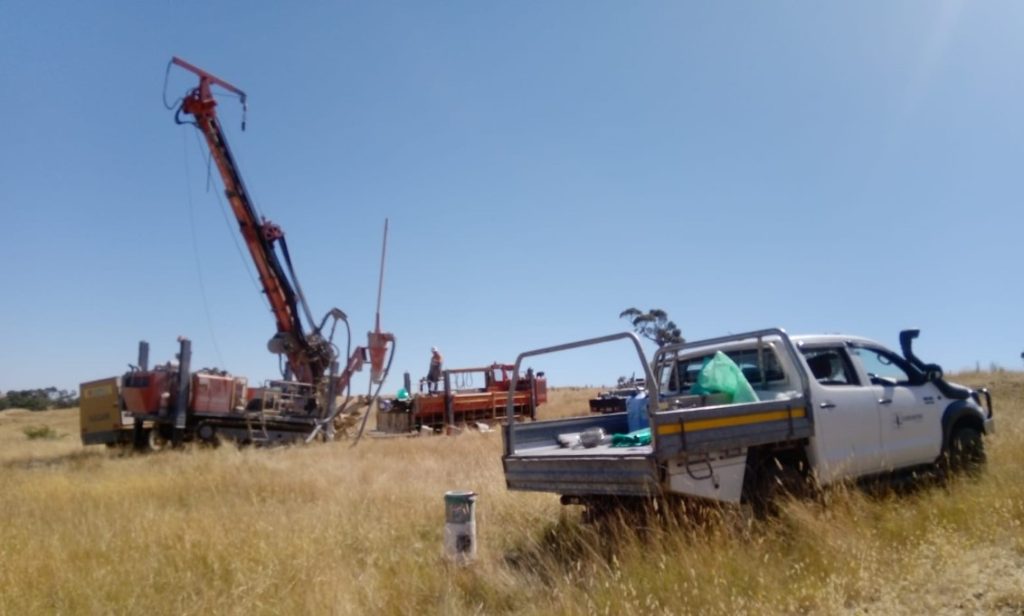Great Pacific Gold drills 25.1 g/t gold over 4 metres at Lauriston, Australia

Great Pacific Gold Corp. [TSXV-GPAC; OTCQX-FSXLF; Germany-4TU] released high-grade gold assays from its initial follow-up diamond drill hole of the Comet gold discovery at the Lauriston gold project in Victoria, Australia.
Diamond drill hole CDH01A intersected 4 metres at 25.1 g/t gold from 99.5 metres, including 0.4 metres at 72.5 g/t gold from 99.5 metres and 1 metre at 55 g/t gold from 102.5 metres, within a broader interval assaying 9m at 11.6 g/t gold from 97 metres.
The high-grade intercept occurs within the core of the Comet Anticline at the fold axis, where the Comet Fault zone junctions with this fold.
The company set up diamond drill hole CDH01A in close proximity of the high-grade reverse circulation (RC) percussion discovery hole CRC07 (8m at 106 g/t gold including 5m at 166 g/t Gold including 2m at 413 g/t Gold including 1m at 468 g/t gold and 1m at 358 g/t gold (from 95 metres)) as a conservative approach to determine extensions of mineralization. The hole CDH01A deviated once underway, steepening with depth and managed to drill about 8 metres down dip of the projected position of the CRC07 intercept.
Diamond drilling confirmed the gold-rich quartz veined fault zone is extending to depth and laterally with this CDH01A result, and the high-grade mineralization remains open in all directions.
Assays remain pending for two more diamond drill holes on the same section at Comet and will be reported once received. One of these diamond drill holes (CDH02) encountered multiple stacked zones of mineralization and due to this was extended by approximately 100 metres versus the originally planned target depth. CDH02 was drilled to 255.5 metres depth.
GPAC Chief Operating Officer and Director, Rex Motton, stated, “The high-grade gold intercept in our first diamond drilling, post the reverse circulation discovery hole at Comet, is a great start to the program. In addition to the high-grade gold interval in the first diamond drill hole assaying 4 metres at 25.1 g/t gold within a broader 9-metre mineralized zone, we also are very pleased with early information from the second hole. While no assays have been received for the second hole, it has already shown importance geologically as multiple zones of mineralization were encountered. The second hole, which was originally planned to a target depth of approximately 150 metres was continued until approximately 255 metres based on these stacked zones of mineralization encountered. We see this as early days for this extensive and highly prospective structure.”
The 9m intercept uses a 0.3 g/t Au cut-off grade and maximum 2m internal waste. The 4m intercept uses a 5.0 g/t Au cut-off grade and maximum 0.6m internal waste, while the higher-grade included intercepts use assays of greater than 40 g/t Au and no internal waste parameter. True widths are not known. Additional drilling is required to determine true widths.
Great Pacific Gold has a portfolio of high-grade gold projects in Papua New Guinea (PNG) and Australia. In PNG, Great Pacific Gold recently acquired a significant 2,166 km2 mineral exploration land package in PNG. The land package comprises of exploration licenses (EL) and exploration license applications (ELA). It includes both early-stage and advanced-stage exploration targets with high-grade epithermal vein and porphyry-style mineralization present.
The Arau Project consists of two exploration licenses, located in the Kainantu region, and includes the Mt. Victor Prospect, where previous drilling found a multiple phase intrusion complex hosting copper and gold mineralization.
The Wild Dog Project consists of one granted exploration license, EL 2761, and one exploration license application, ELA 2516, located on the island of New Britain and about 50 km southwest of Rabaul and Kokopo, PNG.
The Kesar Creek Project consists of one exploration license, EL 2711, and is contiguous with the K92 Mining Inc. tenements.
In Australia, Great Pacific Gold began with two, 100%-owned, high-grade gold projects called the Lauriston and Golden Mountain Projects, and has since acquired a large area of granted and application tenements containing further epizonal (low-temperature) high-grade gold mineralisation and associated intrusion-related gold mineralization all in the state of Victoria, Australia.
The Great Pacific Gold land package, assembled over a multi-year period, notably includes the Lauriston Project which is a 535 km2 property immediately to the south of and within the same geological framework that hosts Agnico Eagle Mines Ltd.’s Fosterville Gold Mine and associated exploration tenements.
The Golden Mountain Project is an intrusion-related gold project on the edge of the Strathbogie granite and occurs at the northern end of the Walhalla Gold Belt. The acquired projects include the epizonal gold Providence Project containing the Reedy Creek goldfield which adjoins the Southern Cross Gold’s Sunday Creek exploration project and a large group of recently consolidated granted tenements called the Walhalla Gold Belt Project, which contain a variety of epizonal and intrusion related style gold mineralisation.
Additionally, Great Pacific Gold has another gold-focused project called the Moormbool project which has epizonal style gold mineralization and associated potential intrusion-related gold mineralization, as well as the Beechworth Project occurs in the northeast of the state and contains intrusion related and mesozonal gold mineralization.
All GPAC’s properties in Australia are 100% owned and have had historical gold production from hard rock sources despite limited modern exploration and drilling.
